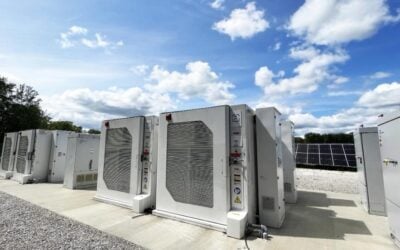Two recent reports, one from credit rating and investment advisory agency Moody’s, the other from technology and tech market analysts Navigant Research, appear to show divergent views on the potential of distributed energy storage, including residential solar-plus-batteries.
Moody’s Investor Service has released a report arguing that in the US, the cost of pairing solar with batteries and the changes in lifestyle required by homeowners to do so will remain prohibitive enough that mass “grid defection” is unlikely to become reality anytime soon. Navigant meanwhile has predicted a big future for the technology within a decade.
Enjoy 12 months of exclusive analysis
- Regular insight and analysis of the industry’s biggest developments
- In-depth interviews with the industry’s leading figures
- Annual digital subscription to the PV Tech Power journal
- Discounts on Solar Media’s portfolio of events, in-person and virtual
Adding to the volume of reports on the subject from leading financial institutions, the Moody's report “Batteries are coming but utilities are not going away”, published last week, claims that while battery costs are falling, storage poses “little risk that residential customers will defect from US utilities".
In December, a report from Accenture argued that solar-plus-storage is one of a number of disruptive technologies that could hit utility revenues by as much as US$130 billion annually within the decade. Meanwhile, the bank Barclays in May of last year advised that solar PV-generated energy coupled with storage presents a long term disruptive risk to electric utilities in the US.
A vice president-senior analyst at Moody’s, Toby Shea, explained the company’s position.
“We believe the cost of batteries in a solar-battery system is still an order of magnitude too expensive to substitute for grid power. The capital cost of batteries today is closer to US$500-600 per kWh. Thus, when we say that battery costs need to be lower by an order of magnitude, we effectively mean costs in the range of US$10-30 per kWh.”
Apparently reiterating an argument which is often made in the US by utilities themselves and the groups that lobby on their behalf, the investor advisory service said utility business models would be “challenged” by the transference of fixed grid costs away from those that had “defected”, onto the utilities’ remaining customers. Mass defection could also damage the credit ratings of utility companies, Moody’s said.
Also arguing that net metering in the US, which requires a grid connection, is prevalent and popular enough to prevent even those with PV from looking at installing batteries, Moody’s claims the number of solar rooftops also remains low, although “growing rapidly”.
Navigant Research meanwhile, headquartered in Colorado, has said that the adoption of commercial and residential storage in 2014 “far exceeded industry expectations for growth and market volume”. The Navigant report takes a global outlook and does not focus exclusively on storage paired with solar but instead looks at distributed energy storage in three sets of circumstances: residential energy storage with and without PV, community energy storage at the distributed transformer level and commercial energy storage.
PV paired with energy storage is installed at a range of houses by German prefabricated home-builder WeberHaus. Image: WeberHaus.
The Navigant report claims annual revenues from distributed storage will reach US$16.5 billion by 2024 from the US$452 million a year it was worth last year, earmarking residential and commercial storage in particular for “significant growth in the coming years”. The rise in revenues will be matched by a vast ramping up in deployed capacity of distributed storage, from 171.9MW in 2014 to 12,147.3MW in 2024, the analysis team said.
While not tackling the phenomenon of possible grid defection directly, Navigant senior research analyst Anissa Dehamma said technological advances are making it possible for the market to progress and grow quickly enough to meet the demands posed by new and possibly disruptive technologies.
“The development of advanced battery chemistries, including lithium ion (Li-ion), flow batteries, advanced lead-acid, and other next-generation chemistries, has enabled rapid advancement in the distributed storage market. These advances are helping to meet demand for distributed and flexible resources created by the spread of solar PV, electric vehicles, electric vehicle charging, and home energy networks.”
The Navigant report acknowledges the challenges posed by cost reduction, as well as talking up the importance both from a technical and business perspective of using advanced software, controls and “integration expertise”.
John Carrington, the chief executive officer of Stem Inc, a start-up which makes energy storage control and prediction analytics software, explained to PV Tech Storage why his company sees software as an important component of energy storage and management systems. Carrington also said that utilities could also benefit from these advances in management and analysis software.
“For businesses and utilities alike, the pairing of storage hardware and intelligent software unlocks an asset that is more efficient and valuable than a battery alone. Software platforms featuring real-time data and predictive analytics can multiply end-user value by providing a complete view of energy usage versus a hardware-only approach,” Carrington said.
“For commercial organizations, software maximizes battery efficiency, enables grid participation, uncovers additional energy savings opportunities and mitigates energy spikes before they become costly line items.”
The Navigant Research report talked up the importance of advances in software and control systems. Image: Stem Inc.
While the Moody’s report also said full grid defection requires much bigger batteries than are commonly available and claimed electricity usage is much more volatile than has been taken into account by some other studies, also claiming that consumers are too accustomed to the convenience of grid power to defect completely.
However, although many solar companies are starting to offer storage, often as part of an “all-in-one” solution that includes a PV array and energy management system, it is rare to find advocates of total grid defection en masse using solar-plus-storage.
As this site has reiterated numerous times, executives at SunPower and SolarCity, two of the biggest companies in US residential solar, have denounced the idea of 100% off-grid living. SolarCity technical officer Peter Rive said that there should be more synergy between solar companies and utilities in a blog on the company’s website, a position company spokesman Will Craven explained to PV Tech Storage in an interview earlier in the year.
“…Utilities are often best positioned to kind of direct stored energy when and where it’s needed and we are perfectly willing to engage in discussions with utilities on how to enable them to utilise behind-the-meter or customer-side storage to manage the grid, for example at peak times when it’s under strain,” Craven said.
“So, we see opportunity. It’s going to require some creative thinking on their [utilities’] part.”
In February of last year, respected energy efficiency and sustainability group the Rocky Mountain Institute (RMI) published “The economics of grid defection", which caught the imagination of many of the press and public. RMI’s report said the spread of disruptive technologies such as solar and battery storage could allow some parts of the US to affordably go off-grid by 2030, if not sooner. However, it is important to note that the report also highlighted significant regional variations in economic, regulatory and technical circumstances which would lead states “over the line” at different points in time. For example, some parts of Hawaii have already reached grid parity, while states such as Kentucky and Texas will not reach parity for solar-plus-batteries until 2047.






